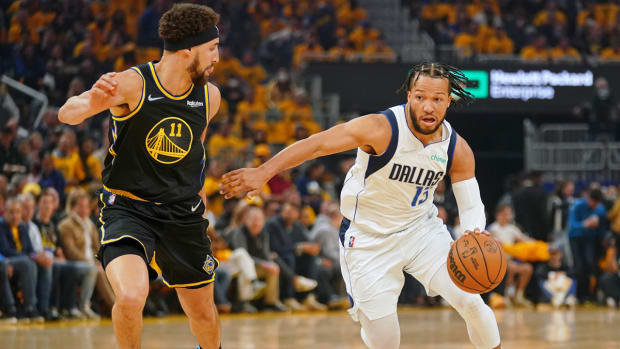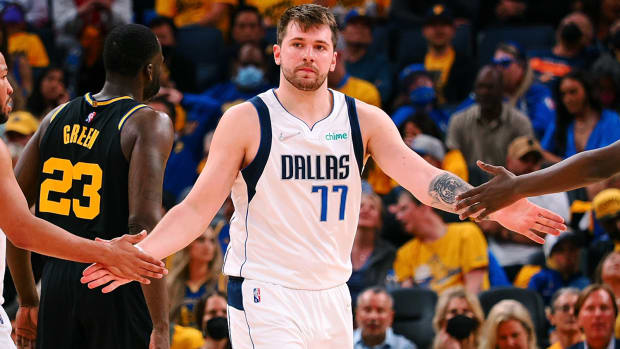Despite experiencing the hollow feeling of elimination Thursday night, the Mavericks have plenty of room to feel optimistic going forward.
Aside from advancing past the disheveled Jazz, marking Dallas’s first postseason series win since earning the NBA crown in 2011, the Mavs obliterated the top-seeded Suns on the road in a resounding Game 7 performance so dominant that Phoenix felt the need to release a statement to fans, saying the club would do better.
Perennial MVP candidate Luka Dončić and the Mavs have now reached the playoffs three years in a row. But the question facing them at the moment is simple: What does the organization need to do to stand in the space the Warriors occupy right now, to reach the NBA Finals?
The Jalen Brunson question
The biggest, most expensive order of business figures to be one that’s been staring the Mavs in the face for months now. How much will it cost Dallas to bring back Brunson, the team’s stout, bulldozing guard, who rates as one of the best point guards available in a relatively weak free-agent class?
Brunson, who turns 26 later this summer, averaged a career-best 16.3 points during the season and shredded Utah to the tune of 27.8 points per contest in the opening round. For his size, at just 6'1", he’s historically efficient as a finisher around the basket and coming off a third season in four years in which he shot an eye-popping 70% or better within three feet of the rim, according to data from Basketball Reference.
As the team’s best, most reliable scorer after Dončic, it would be a blow to lose him. But the former second-round pick, who made just $1.8 million this season, figures to make high-end starter’s money on his next deal, which could translate to upward of $20 million per year. “He’s going to make a lot of money. I don’t know if he needs an agent, but I’m gonna put my name in the hat,” Dallas coach Jason Kidd joked during the first round, as Brunson dominated the Jazz.

Cary Edmondson/USA TODAY Sports
Mark Cuban, the Mavericks’ owner, spoke confidently about the prospect of bringing Brunson back following the club’s elimination. “Obviously after re-signing JB, we’re gonna get together and really focus on the type of J-Kidd player: guys who can guard multiple positions, who are tough, know their role, are physical, that have a motor,” he told Hall of Fame scribe Marc Stein.
When Stein pointed out to Cuban that he’d spoken with more of a “when” rather than an “if” on Brunson, Cuban pushed even further. “We can pay him more than anybody. I think he wants to stay, and that’s most important,” he said.
What comes next at the center spot?
Part of what’s made the Warriors so great over the years is their ability to neutralize what other teams excel at. With their elite, exhausting cutting and back-door screening, they regularly make good defenses look silly.
That was certainly the reality in this series, in which Dallas kept getting beat by Kevon Looney, who’d quietly slip behind the Mavs’ defense after an array of Warriors passes. And even when that wasn’t the case, like in Game 2, where Dallas surrendered an incredible 15-of-19 from the field in a dismal fourth quarter, Golden State often dominated the offensive glass. The Warriors grabbed a third of their own misses in Game 5, converting them into 17 points. The Dubs also notched 18 second-chance points in their Game 3 victory, illustrating that the Dallas defense was stretched too thin.
Starting big man Dwight Powell averaged just under 10 minutes per game in this series, and took just five shot attempts total. Maxi Kleber showed his ability to extend his defense well out past the three-point line to often force Stephen Curry to do his damage from inside the arc. But following the trade of Kristaps Porziņģis, whose move gave the Mavs more fractionalized cap flexibility in the form of Spencer Dinwiddie and Dāvis Bertāns, Dallas could use more size and deterrence around the paint.
You’ll see some big names tied to the Mavs, ranging from the Pacers’ Myles Turner to someone more elite like Rudy Gobert, as players who would make sense. Trades would obviously be necessary to bring in that sort of talent. But the bottom line is simple: The solid defense would be far more solid if it had an elite, seven-foot rim protector as opposed to relying so heavily on Kleber—who is 6’10”, and more of a power forward—being used in that role so often.
Freeing up Dončić to do more

Kelley L Cox/USA TODAY Sports
Keeping Brunson in the fold would obviously be one way for the Mavericks to breathe more easily when Dončić is on the bench or off the ball.
But even with Brunson on the roster, it’s fair to wonder whether Dončić is simply relied upon to do too much for this Dallas team. At 37.4%, his usage rate was the highest in the league this season—a touch higher than Joel Embiid’s, even. He also owned the NBA’s highest usage in 2020–21, when 36% of the Mavericks’ possessions ended with him. And those numbers only increased in the postseason, a stretch in which Dončić used an NBA-high 40% of his team’s possessions.
It raises the question of whether it’s realistically sustainable for Dončić to carry that heavy of a weight on his shoulders for four consecutive rounds en route to a championship. Even if he could, it’s worth wondering whether that strain has a ripple effect in other ways. The potential for injury would always seem to be greater the more someone is asked to do. (His performance improved after the first month or two of the season, after acknowledging that he’d been out of shape to begin the year.)
Beyond that, asking so much of Luka on one end almost certainly leaves him with less in the tank on the other. Just like the Mavericks made a point of relentlessly targeting the aging Chris Paul on pick-and-rolls to wear him down one round earlier, Dallas got doses of its own medicine when the Warriors did that to Dončić. (Phoenix certainly hunted Dončić, too, during that series.) They put him in pick-and-rolls when they could. And Andrew Wiggins was as aggressive offensively as we’ve ever seen him, seemingly recognizing that Golden State could land a TKO of sorts by requiring Dončić to lay out more effort on that end.
Two things can simultaneously be true: The 23-year-old needs to provide more resistance defensively from one play to the next for Dallas to improve even further on that end. (Steve Kerr issued that challenge to Curry upon taking the Warriors’ job.) But the Mavs need to generate more offense without him, which would leave him with more energy to contribute meaningfully on D. There were times it looked almost like a designated hitter arrangement. But some give and take would work wonders for the team if it can strike a better balance.
Finding more transition opportunities
Among the things that would make life easier for Dončić: the Mavs getting easier baskets, which would cut down on the ballhandler needing to use the entirety of the shot clock to create a good look.
Along with Dončić owning the highest usage rate, Dallas ranked dead last in the NBA in pace this season, making the comparisons between Dončić and James Harden relevant on perhaps one more level. Those Houston clubs were notoriously slow as they alternated between an abundance of pick-and-rolls and one-on-one sets for long stretches of games.
Avoiding being in the half court so frequently would lift the team’s efficiency. And while playing a track-meet pace would surely tire out anyone, Dončić included, there’s something to be said for building out a bench that utilizes more pace and athleticism to find quicker scores.
Experimenting with giving Dinwiddie the keys for such a plan could be a good start in that regard. Among the 287 players who had 50 or more possessions in transition, Dinwiddie rated as the worst transition scorer in basketball with Washington, per Synergy Sports, scoring just 49 points in 66 possessions with the Wizards. But he essentially flipped those numbers upside down, scoring 64 points on 47 transition possessions upon joining the Mavs, ranking in the league’s 88th percentile, and scoring almost 64% of the time.
There’s obviously a time and a place for your MVP candidate to go out and make a play for you. But if Dallas could swap out some of those times and places for a few more transition opportunities per game, it could make life a bit easier for everyone.







